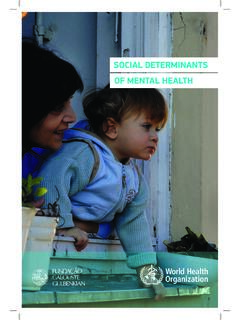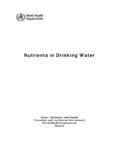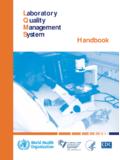Transcription of Chronic Suppurative Otitis Media - World Health Organization
1 Chronic Suppurative Otitis mediaBurden of Illness and Management OptionsChild and Adolescent Health and DevelopmentPrevention of Blindness and DeafnessWorld Health OrganizationGeneva, Switzerland2004 AcknowledgementsThis document was written by Dr Jose Acuin, Philippines, and jointly prepared bythe Department of Child and Adolescent Health and Development and the Team forPrevention of Blindness and Deafness of the World Health Organization . A specialdebt of gratitude is also owed to the reviewers, Stephen Berman, Peter Morris, andPiet van library cataloguing -in- publication DataChronic Suppurative Otitis Media : burden of illness and management Media , Suppurative management disease epidemiology of illness , Jose Health 92-4-159158 7(NLM classification: WV 232) World Health Organization 2004 All rights reserved.
2 Publications of the World Health Organization can be obtained from Marketing and Dissemination, World Health Organization , 20 Avenue Appia, 1211 Geneva 27, Switzerland (tel: +41 22 791 2476; fax: +41 22 791 4857;email: Requests for permission to reproduce or translate WHO publications whether for sale orfor noncommercial distribution should be addressed to Publications, at the above address (fax: +41 22 791 4806; designations employed and the presentation of the material in this publication do not imply the expression of anyopinion whatsoever on the part of the World Health Organization concerning the legal status of any country, territory,city or area or of its authorities, or concerning the delimitation of its frontiers or boundaries.))
3 Dotted lines on maps repre-sent approximate border lines for which there may not yet be full mention of specific companies or of certain manufacturers products does not imply that they are endorsed orrecommended by the World Health Organization in preference to others of a similar nature that are not and omissions excepted, the names of proprietary products are distinguished by initial capital World Health Organization does not warrant that the information contained in this publication is complete andcorrect and shall not be liable for any damages incurred as a result of its by Ilka Linz, BerlinPrinted in Switzerland2 ForewordChronic Suppurative Otitis Media (CSOM) is a major cause of acquired hearingimpairment in children, especially in developing countries.
4 Most approaches totreatment have been unsatisfactory or are very expensive and difficult; for exampleparenteral aminoglycosides require long hospitalization and are potentially situation is reflected in the IMCI recommendation only to wick the ear, but notto use any antibiotics. If the child continues to have a discharging ear on day 5 offollow-up, the consequence is to encourage further wicking. This is unsatisfactory,as the child's caretaker sees no real option for treatment, and may search for alterna-tives from other sources, spending money and losing trust in the Health developments in the treatment of Chronic Otitis Media include evidence forthe efficacy of antibiotics, especially with the introduction of topical quinolones,which are reported to have high effectiveness and are relatively easily administered,but remain questions are of interest to Health workers throughout the World .
5 TheDepartment of Child and Adolescent Health and Development and the Team forPrevention of Blindness and Deafness at WHOhave prepared this technical mono-graph which addresses the epidemiology and burden ofCSOMin different countries,its diagnosis and consequences in individuals, and currently used managementoptions and their cost-effectiveness. It proposes scenarios for management of thedisease according to different presentations and an assessment is made of the feasibi-lity and impact of each is hoped that the document will provide an overview of current knowledgeabout CSOMand a scientific basis for action, especially in developing of ContentsForeword 3 Summary 7 Chapter One Global burden of disease due to Chronic Suppurative otitismedia.
6 Disease, deafness, deaths and DALYs9 Introduction9 Definition of CSOM9 Difference between CSOM and other forms of Chronic Otitis media10 Bacteriology ofCSOM10 Histopathological features ofCSOM11 Effects of deafness on child development11 Complications ofCSOM12 Risk factors for CSOM12 Disease burden13 Review of prevalence studies13 Table 1. Classification of countries according to CSOM prevalence14 Table 2. Prevalence of CSOM, by region and country14 Fig. 1. Relationship of different definitions to CSOM16 Regional CSOM prevalence estimates17 Table 3. Global distribution of CSOM, by region (using low prevalence rates)19 Table 4. Global distribution of CSOM, by region (using high prevalence rates)19 Fig.
7 2. Regional contributions to the global CSOM using low and high prevalence estimates 19 Hearing impairment20 Review of prevalence of CSOM-associated hearing impairment20 Table 5. Frequency of hearing impairment from CSOM in different study settings20 Regional hearing impairment prevalence estimates21 Table 6. Regional burden ofCSOMand hearing impairment from CSOM,1990 21 Deaths22 Review of CSOM-related mortality rates22 Causes ofCSOM-related deaths224 DALYs23 Review of global burden of disease from Otitis media23 Table 7. Deaths, years of life lost, years lived with disability, and DALYS from otitismedia, by region23 Chapter Two Diagnosis of CSOM25 Diagnosis by history-taking25 Diagnosis by otoscopy26 The diagnostic value of bacterial cultures28 Chapter Three Management of CSOM29 Features ofCSOM that can be managed medically29 Literature review30 Aural toilet30 Aural toilet is no better than no treatment30 Practical implications31 Antimicrobial treatments32 Oral antibiotics 33 Topical antibiotics33 Practical implications35 Table 8.
8 Topical antibiotics for CSOM, as reported in the literature35 Parenteral antibiotics36 Table 9. Parenteral antibiotics for CSOM37 Topical antiseptics37 Table 10. Topical antiseptics, as reported in the literature38 Fig. 3. Summary results of systematic review of treatments for CSOM39 Cost-effectiveness analysis of different interventions for CSOM40 Effectiveness data41 Table 11. Cost-effectiveness analysis of alternative treatments to ear wicking43 Surgery43 Literature review44 Table 12. Results of mastoidectomy for CSOM45 Practical implications46 Chapter Four Management scenarios47 Management scenario 1 Patient with a newly discharging ear, with no previoustreatment485 Management scenario 2 Patient with a previously treated but newly dischargingear53 Management scenario 3 Patient with a recurrent discharging ear, with or withoutprevious treatment56 Role and impact of ear camps and outreach mastoidectomy 13.
9 Regional distribution ofCSOM cases without access to otological servicesand to mastoidectomy59 Table 14. data on patients in Thai outreach programmes in three Asian countries59 Table 15. Number of ear camps in three regions and the estimated time for reducingthe mastoidectomy backlog62 Management scenario 4 Patient with a recurrent discharging ear, with ear swelling or pain or fever63 Management scenario 5 Patient with no discharge but with hearing loss64 Feasibility of management scenarios65 Table 16. Regional distribution of ENT specialists per million population65 Summary of the management scenarios66 Fig. 4. Management scenario algorithm66 Impact of management scenarios68 Table 17. Cost-effectiveness analysis of alternative treatments to ear wicking, in terms ofresolution of otorrhoea69 Fig.
10 5. Reduction of draining ears with management scenarios 1, 2 and 369 Table 18. Cost-effectiveness analysis of alternative treatments to ear wicking, in terms ofrestoration of hearing70 References 716 SummaryChronic Suppurative Otitis Media (CSOM) is the result of an initial episode of acuteotitis Media and is characterized by a persistent discharge from the middle earthrough a tympanic perforation. It is an important cause of preventable hearingloss, particularly in the developing surveys, which vary widely in disease definition, sampling methods,and methodologic quality, show that the global burden of illness from CSOM invol-ves 65 330 million individuals with draining ears, 60% of whom (39 200 million)suffer from significant hearing for 28 000 deaths and adisease burden of over 2 million DALYs.












